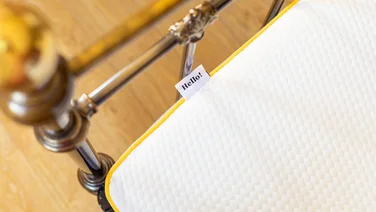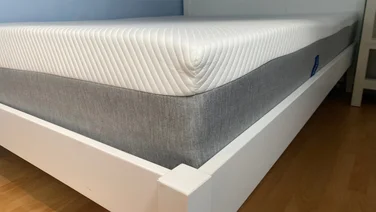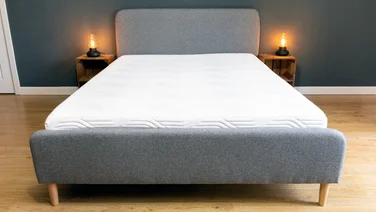To help us provide you with free impartial advice, we may earn a commission if you buy through links on our site. Learn more

Latex is the latest material of choice for many premium mattress brands – it can also be found in pillows or mattress toppers – but what is latex? And what makes a latex mattress so special?
Our handy explainer will take you through everything you need to know about this increasingly popular mattress material, from how it’s made to how comfortable it really is. Then we’ll compare the pros and cons of a latex mattress so you can make an informed decision when you’re buying your next mattress.
What is latex?
Latex is a form of rubber, primarily sourced from Amazonian rubber trees that are tapped for their soft white sap. This latex sap is a natural material that has been used for decades in making anything from shoes to chewing gum, rubber bands and, more recently, mattresses.

Harvesting latex sap only involves cutting the bark of the rubber tree, without disrupting the tree’s growth, so it can be part of a sustainable practice.
READ NEXT: Best mattresses
How are latex mattresses made?
Latex mattresses typically consist of a thick sheet, or several sheets, of latex which has been mixed with compressed air to achieve the right foamy consistency for a mattress. The tiny air bubbles infused in the latex give it an open cell structure, which makes it breathable as well as cushiony and supportive.
What is a hybrid mattress?
Most mattresses that use latex also use other materials, creating what’s known as a hybrid mattress, to achieve a better result. So, you may find a pocket-sprung mattress with a latex layer on top for added comfort, or a mattress containing a blend of latex and memory foam layers allowing you to enjoy the benefits of both.
In our testing, we loved the Origin Hybrid, which features a base layer of pocket springs, a cooling gel-infused memory foam layer, foam edge support and an ‘IceCool’ natural latex layer. We awarded it five out of five stars and our ‘Recommended’ rating.
READ NEXT: Emma vs Simba: Which is better?
What are the differences between latex and memory foam?
You can read our longer explainer, ‘What is memory foam?’, for all the nitty gritty on memory foam but, if you’re struggling to choose between these two super mattress materials then you need to consider how you sleep and the size of your budget.
Latex is natural and springy while being less conforming than memory foam. It’s also cooler to sleep on and more eco-friendly. However, it’s significantly more expensive than memory foam.

Memory foam is synthetic and not easily recyclable, but far more affordable – just take a look at the Dormeo Memory Plus, which we said was “unbeatable value” and awarded our coveted ‘Best Buy’. However, it often comes with an unpleasant chemical smell when you first unpackage it, and can be problematic for hot sleepers too.
What are the advantages of a latex mattress?
- Breathable: Aerated latex foam has an open-cell structure which makes it easier for air to circulate. This is good in terms of hygiene as well as making for a cooler sleeping experience – particularly when compared to memory foam.
- Elasticity: Latex is naturally super-springy and great at shape retention. This means that, when you roll over to a new position, the mattress will recover much more quickly than other materials.
- Hypoallergenic: Anyone with allergies will appreciate the hypoallergenic qualities of latex.
- Supportive: Latex is a firmer and more supportive mattress material than many others, so it’s suitable for medium to heavy body types, as well as lighter people. It is comfortable for sleeping in all positions as it offers superior contouring to support spine alignment. We rate the Dunlopillo Royal Sovereign – it’s a comfortable and supportive mattress that will suit all types of sleepers, though we particularly recommend it for back sleepers.
- Durable: Latex mattresses have an average lifespan of 10-20 years, almost double that of other mattresses.
- Environmentally friendly: As latex is made from natural rubber sap, it is biodegradable and recyclable, whereas synthetic mattresses contribute significantly to landfill – check out our guide to responsible mattress disposal.
READ NEXT: Best mattresses for a bad back
What are the disadvantages of a latex mattress?
- Expensive: Its eco-credentials, performance and durability mean that latex comes at a price – you’ll be looking at roughly double that of other similar mattresses. If you love the idea of a latex mattress but it’s out of your price range, consider the Simba Hybrid which uses a layer of what they call ‘Simbatex’, a material that mimics latex and our tester found was “spot on in terms of firmness and comfort” or consider the affordable Simba Hybrid Topper.
- Smell: Just as memory foam comes with a tell-tale chemical smell, latex mattresses can be accompanied by a slightly rubbery aroma, but if you’re putting it in a well-ventilated room, this should dissipate after a few days.
- Weight: Latex can be heavy, so consider how you will turn the mattress, including whether it has handles.
Is latex not for you? Explore other mattress types and take an in-depth look at the different varieties available in our mattress buying guide.






